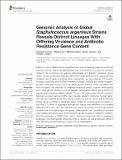Files in this item
Genomic analysis of global Staphylococcus argenteus strains reveals distinct lineages with differing virulence and antibiotic resistance gene content
Item metadata
| dc.contributor.author | Goswami, Cosmika | |
| dc.contributor.author | Fox, Stephen | |
| dc.contributor.author | Holden, Matthew | |
| dc.contributor.author | Leanord, Alistair | |
| dc.contributor.author | Evans, Thomas J | |
| dc.date.accessioned | 2021-12-23T10:30:18Z | |
| dc.date.available | 2021-12-23T10:30:18Z | |
| dc.date.issued | 2021-12-02 | |
| dc.identifier | 277198476 | |
| dc.identifier | 3c06e0b3-8984-4729-af3b-57f80ee56a24 | |
| dc.identifier | 34925305 | |
| dc.identifier | 85121338534 | |
| dc.identifier | 000730752600001 | |
| dc.identifier.citation | Goswami , C , Fox , S , Holden , M , Leanord , A & Evans , T J 2021 , ' Genomic analysis of global Staphylococcus argenteus strains reveals distinct lineages with differing virulence and antibiotic resistance gene content ' , Frontiers in Microbiology , vol. 12 , 795173 . https://doi.org/10.3389/fmicb.2021.795173 | en |
| dc.identifier.issn | 1664-302X | |
| dc.identifier.other | PubMedCentral: PMC8677677 | |
| dc.identifier.other | ORCID: /0000-0002-4958-2166/work/105318462 | |
| dc.identifier.uri | https://hdl.handle.net/10023/24568 | |
| dc.description | This work was funded by the Scottish Executive via the Chief Scientists Office through the provision of a grant to establish the Scottish Healthcare Associated Infection Prevention Institute (SHAIPI). | en |
| dc.description.abstract | Infections due to Staphylococcus argenteus have been increasingly reported worldwide and the microbe cannot be distinguished from Staphylococcus aureus by standard methods. Its complement of virulence determinants and antibiotic resistance genes remain unclear, and how far these are distinct from those produced by S. aureus remains undetermined. In order to address these uncertainties, we have collected 132 publicly available sequences from fourteen different countries, including the United Kingdom, between 2005 and 2018 to study the global genetic structure of the population. We have compared the genomes for antibiotic resistance genes, virulence determinants and mobile genetic elements such as phages, pathogenicity islands and presence of plasmid groups between different clades. 20% (n = 26) isolates were methicillin resistant harboring a mecA gene and 88% were penicillin resistant, harboring the blaZ gene. ST2250 was identified as the most frequent strain, but ST1223, which was the second largest group, contained a marginally larger number of virulence genes compared to the other STs. Novel S. argenteus pathogenicity islands were identified in our isolates harboring tsst-1, seb, sec3, ear, selk, selq toxin genes, as well as chromosomal clusters of enterotoxin and superantigen-like genes. Strain-specific type I modification systems were widespread which would limit interstrain transfer of genetic material. In addition, ST2250 possessed a CRISPR/Cas system, lacking in most other STs. S. argenteus possesses important genetic differences from S. aureus, as well as between different STs, with the potential to produce distinct clinical manifestations. | |
| dc.format.extent | 18 | |
| dc.format.extent | 12108337 | |
| dc.language.iso | eng | |
| dc.relation.ispartof | Frontiers in Microbiology | en |
| dc.subject | Staphylococcus argenteus pathogenicity islands | en |
| dc.subject | Staphylococcus argenteus, | en |
| dc.subject | Antibiotic resistance | en |
| dc.subject | Virulence genes | en |
| dc.subject | CRISPR/Cas | en |
| dc.subject | QR Microbiology | en |
| dc.subject | DAS | en |
| dc.subject.lcc | QR | en |
| dc.title | Genomic analysis of global Staphylococcus argenteus strains reveals distinct lineages with differing virulence and antibiotic resistance gene content | en |
| dc.type | Journal article | en |
| dc.contributor.institution | University of St Andrews. School of Medicine | en |
| dc.contributor.institution | University of St Andrews. Biomedical Sciences Research Complex | en |
| dc.contributor.institution | University of St Andrews. St Andrews Bioinformatics Unit | en |
| dc.contributor.institution | University of St Andrews. Infection and Global Health Division | en |
| dc.identifier.doi | 10.3389/fmicb.2021.795173 | |
| dc.description.status | Peer reviewed | en |
This item appears in the following Collection(s)
Items in the St Andrews Research Repository are protected by copyright, with all rights reserved, unless otherwise indicated.

